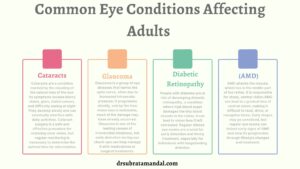
As we reach the age of 40, our bodies undergo numerous changes, and our eyes are no exception. You may experience sudden changes in your vision, and the risk of certain eye diseases increases. Unfortunately, many adults ignore eye health until a problem arises, but early detection through regular eye check-ups can help maintain clear vision and prevent serious complications.
This guide will help you understand why scheduling regular eye check-ups after 40 is vital, what changes to expect, common conditions to watch for, and how to protect your vision in this new phase of life.
Notable Vision Changes After 40
If you are above the age of 40, you will notice changes such as:
- Presbyopia (difficulty seeing close objects clearly), leading to the need for reading glasses.
- Increased glare sensitivity, especially while driving at night
- Changes in colour perception
- Reduced tear production makes you vulnerable to Dry Eye Syndrome
- Difficulty adjusting to lighting changes
These changes often indicate the gradual onset of fatal eye conditions. Therefore, do not ignore them.
Common Eye Conditions Affecting Adults

While minor vision changes are common after 40, certain eye conditions become more prevalent, and many do not show early symptoms. Regular eye check-ups allow early diagnosis and management, reducing the risk of irreversible vision loss.
Cataracts
Cataracts are a condition marked by the clouding of the natural lens of the eye. Its symptoms include blurry vision, glare, faded colours, and difficulty seeing at night. They develop slowly and can eventually interfere with daily activities. Cataract surgery is a safe and effective procedure for restoring clear vision, but regular monitoring is necessary to determine the optimal time for intervention.
Glaucoma
Glaucoma is a group of eye diseases that harms the optic nerve, often due to increased intraocular pressure. It progresses silently, and by the time vision loss is noticeable, much of the damage may have already occurred. Glaucoma is one of the leading causes of irreversible blindness, but early detection during eye check-ups can help manage it with medications or surgical treatments.
Diabetic Retinopathy
People with diabetes are at risk of developing diabetic retinopathy, a condition where high blood sugar damages the tiny blood vessels in the retina. It can lead to vision loss if left untreated. Regular dilated eye exams are crucial for early detection and timely treatment, especially for individuals with longstanding diabetes.
Age-related Macular Degeneration (AMD)
AMD attacks the macula, which lies in the middle part of the retina. It is responsible for sharp, central vision. AMD can lead to a gradual loss of central vision, making it difficult to read, drive, or recognise faces. Early stages may go unnoticed, but regular eye exams can detect early signs of AMD and slow its progression through lifestyle changes and treatment.
How often should you get an Eye Checkup after 40?
The best recommendation for adults over the age of 40 would be:
- A comprehensive eye check-up every 1-2 years, even in cases where there are no symptoms
- Annual eye exams are recommended for individuals with risk factors such as diabetes, hypertension, a family history of glaucoma, or those already using prescription glasses.
- Immediate consultation if you notice sudden vision changes, flashes of light, floaters, or eye pain.
What happens during Eye Checkups?
A general eye checkup usually includes:
- Review of medical and family history to assess risk factors.
- Visual acuity test to check your ability to see at various distances.
- Refraction test to determine the need for glasses or lens changes.
- Slit-lamp examination to inspect the front part of the eye for conditions like cataracts.
- Tonometry to measure intraocular pressure for glaucoma screening.
- Dilated eye examination to evaluate the retina and optic nerve for signs of AMD, diabetic retinopathy, or other retinal conditions.
- Discussion of findings and management plan, including lifestyle and treatment advice.
Eye Health Tips for Individuals Above 40
Along with undergoing regular eye-checkups, you also need to take care of your eyes. Here are some tips:
- Maintain a healthy diet rich in green leafy vegetables, colourful fruits, fish, and nuts, which are good for eye health.
- Stay physically active to control diabetes, hypertension, and cholesterol levels, reducing the risk of diabetic retinopathy and vascular eye problems.
- Wear sunglasses to protect your eyes from harmful UV rays.
- Use adequate lighting while reading and working to reduce eye strain.
- Limit screen time and follow the 20-20-20 rule: every 20 minutes, look at something 20 feet away for at least 20 seconds
- Avoid smoking, which increases the risk of cataracts and AMD.
- Manage chronic conditions like diabetes and hypertension diligently with regular medical follow-ups.
- Stay hydrated to avoid dry eyes.
- Use protective eyewear during activities that could pose a risk of eye injury
Schedule Your Appointment Today:
- Phone: 9874664924
- Online Booking: click here
Conclusion
Your eyes go through major changes as you age, and neglecting them can lead to avoidable vision impairment or blindness. Regular eye check-ups after 40 help detect problems early, allowing prompt treatment and preserving your vision for years to come.
By being proactive with routine eye examinations and adopting healthy lifestyle practices, you can continue to enjoy clear vision and independence as you age. Your eyes are your window to the world—take care of them, and they will take care of you. If you have crossed 40 and haven’t had an eye examination recently, schedule an appointment today to take the first step toward protecting your vision. Take care of your eyes while there is still time!


